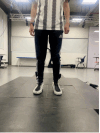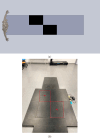Design of a low-cost force insoles to estimate ground reaction forces during human gait
- PMID: 39398532
- PMCID: PMC11471240
- DOI: 10.1016/j.ohx.2024.e00589
Design of a low-cost force insoles to estimate ground reaction forces during human gait
Abstract
This paper proposes a low-cost electronic system for estimating ground reaction forces (GRF) during human gait. The device consists of one master node and two slave nodes. The master node sends instructions to slave nodes that sample and store data from two force insoles located at the participant's feet. These insoles are equipped with 14 piezo-resistive FlexiForce A301 sensors (FSR). The slave nodes are attached to the ankles and feet of each participant. Subsequently, the start command is transmitted through the master node, which is connected to the USB port of a personal computer (PC). Once the walking session is completed, the information obtained by the slave nodes can be downloaded by accessing the access point generated by these devices through Wi-Fi communication. The GRF estimation system was validated with force platforms (BTS Bioengineering P6000, Italy), giving on average a fit measure equal to in dynamic situations. Future versions of this device are expected to increase this fit by using machine learning models.
Keywords: 3D printing; ESP32 microcontrollers; Force insoles; Ground reaction forces; Low-cost; Piezo-resistive sensors.
© 2024 The Authors. Published by Elsevier Ltd.
Figures
























Similar articles
-
Estimation of gait events and kinetic waveforms with wearable sensors and machine learning when running in an unconstrained environment.Sci Rep. 2023 Feb 9;13(1):2339. doi: 10.1038/s41598-023-29314-4. Sci Rep. 2023. PMID: 36759681 Free PMC article.
-
Electronic system for step width estimation using programmable system-on-chip technology and time of flight cameras.HardwareX. 2020 Jul 18;8:e00126. doi: 10.1016/j.ohx.2020.e00126. eCollection 2020 Oct. HardwareX. 2020. PMID: 35498248 Free PMC article.
-
A Systematic Approach to the Design and Characterization of A Smart Insole for Detecting Vertical Ground Reaction Force (vGRF) in Gait Analysis.Sensors (Basel). 2020 Feb 11;20(4):957. doi: 10.3390/s20040957. Sensors (Basel). 2020. PMID: 32053914 Free PMC article.
-
Estimating Ground Reaction Force and Center of Pressure Using Low-Cost Wearable Devices.IEEE Trans Biomed Eng. 2022 Apr;69(4):1461-1468. doi: 10.1109/TBME.2021.3120346. Epub 2022 Mar 18. IEEE Trans Biomed Eng. 2022. PMID: 34648428 Free PMC article.
-
A feasibility study on using soft insoles for estimating 3D ground reaction forces with incorporated 3D-printed foam-like sensors.Wearable Technol. 2025 Jan 23;6:e3. doi: 10.1017/wtc.2024.23. eCollection 2025. Wearable Technol. 2025. PMID: 39935598 Free PMC article.
References
-
- Guo R., Cheng X., Hou Z.-C., Ma J.-Z., Zheng W.-Q., Wu X.-M., Jiang D., Pan Y., Ren T.-L. A shoe-integrated sensor system for long- term center of pressure evaluation. IEEE Sens. J. 2021;21(23):27037–27044. doi: 10.1109/JSEN.2021.3116249. [Online]. Available: - DOI
-
- Choi H., Lee C., Shim M., Han J., Baek Y. Design of an artificial neural network algorithm for a low-cost insole sensor to estimate the ground reaction force (GRF) and calibrate the center of pressure (CoP) Sensors (Switzerland) 2018;18(12) doi: 10.3390/s18124349. [Online]. Available: - DOI - PMC - PubMed
LinkOut - more resources
Full Text Sources

